Behavior Driven Development (BDD) Testing
What is BDD?
Behavior-Driven Development (BDD) is a software development technique for automated testing and it also can be successfully applied in Agile or other software development models. It focuses on the language and interactions used in the process of software development. Instead of a business stakeholder passing requirements to the development/test teams without much opportunity for feedback, the developer, stakeholder and tester collaborate to write acceptance tests that express the outcome that the stakeholder wants. The acceptance tests express what the software needs to do in order for the stakeholder to find it acceptable. BDD practitioners work from the outside-in, starting with a failing acceptance test that describes the behavior of the system from the customer's point of view. Acceptance tests are written as examples that anyone on the team can read. Acceptance tests also encourage to get feedback from the business stakeholders about whether we are setting out to build the right thing before we get started on the development. A shared ubiquitous language is developed for talking about the system as acceptance tests. Then those acceptance tests are automated using one of the BDD tools mentioned in one of the sections below to provide quick and continuous feedback to the team.
Ubiquitous Language
A Ubiquitous language is used and understood by everyone involved in the project. When the team uses this language consistently in their conversations, documentation, and code, the friction of translating between everyone's different little dialects is gone, and the chances of misunderstandings are greatly reduced. Acceptance tests are written in this language that business stakeholders can understand. By collaboratively working to write these tests, not only do the team members decide what behavior they need to implement next, but they learn how to describe that behavior in a common language that everyone understands.
When we write these tests before development starts, we can explore and eradicate many misunderstandings long before they ooze their way into the code base. Acceptance tests written in this manner can easily be read and written by anyone on the team.
Gherkin
Gherkin is an Ubiquitous language for BDD. It enables to express the acceptance tests in plain English. Gherkin syntax is used when writing BDD specifications. This syntax is readable by anyone and it is domain specific language that allows you to describe the behavior of the system and not specifying the details of how that behavior is implemented. This allows using real-world examples to describe the desired behavior of the system we want to build.
It serves two purposes:
- Documentation - The BDD acceptance tests can fulfill Design Control documentation as they contain acceptance criteria.
- Automated Tests - The tests will be automated and this serves as automated acceptance tests."
Given, When and Then are the main BDD keywords:
- Given step represents a precondition to an event
- When step represents the occurrence of the event
- Then step represents the outcome of the event
Acceptance tests written in gherkin format will serve as Requirements and will read like documentation.
Typical BDD Steps within a Program
- In software programs using Agile, typically Product Owner (PO) writes stories.
- PO/Tester writes BDD scenarios in collaboration with Development Architect/Tech Lead
- Tester/Developer writes automated acceptance tests for scenarios using one of BDD tools
- Tester/Developer runs test and watch it fail
- Developer writes production code using TDD
- Run automated acceptance tests until they pass so story can be accepted as complete
- Move to the next scenario/story
If programs don't follow agile software development, Product Manager in collaboration with engineering shall provide enough input based on which BDD scenarios can be written. Decision shall be made by the team who will be writing BDD scenarios
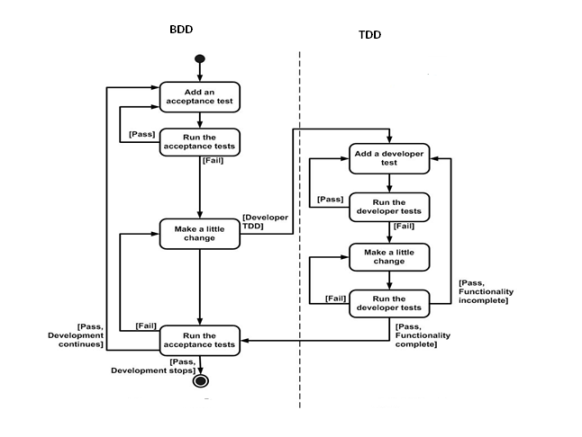
BDD Process
BDD is a two-stage process. The first stage is to write Acceptance Tests in the form of BDD scenarios using Gherkin syntax in collaboration with business stakeholder, developers and testers. The second stage is to automate those acceptance tests created in step one using one of the BDD automated tools. This will ensure that we are applying the best technical practices to build the product right.
Writing BDD Specifications
Acceptance tests are written using Gherkin syntax in the form of Given/When/Statements. The keywords that are used to define acceptance tests are:
- Given
- When
- Then
- Feature
- Background
- Scenario
- And
- But
- Scenario Outline
- Examples
Examples
Feature: Login to application
Scenario 1: User logs in with valid credentials
Given login screen is displayed on trying to access the application
When I enter valid user credentials
Then I should see viewer page
Scenario 2: User logs in with invalid credentials
Given login screen is displayed on trying to access the application
When I enter invalid user credentials
Then a message should be displayed saying that invalid user credentials have been entered
BDD Automation
The second stage in the BDD process is automating the acceptance tests written in Given/When/Then format. The BDD automation can be performed at the API/Services/Web Services and at the User Interface (UI) layers of the application.
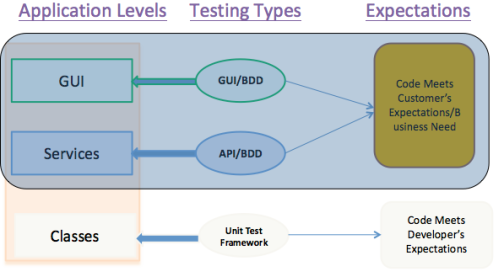
BDD Automation Tools
The figure below shows recommended BDD tools to be used to automate testing for each layer within a typical application. The sections that follow provide more details about each recommended tool as well as some examples.
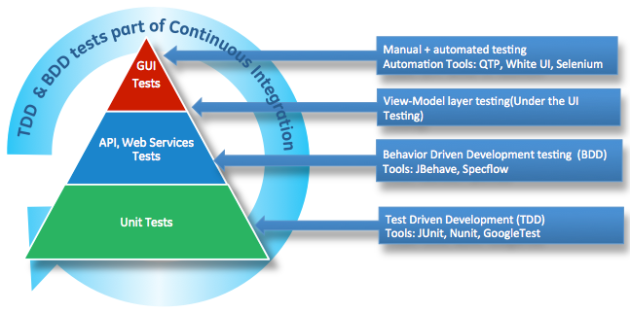
SpecFlow – BDD tool for .Net
SpecFlow is a BDD tool to test .Net based applications. It aims at bridging the gap between technical and non-technical stakeholders by binding the acceptance tests written in Given/When/Then statements to the underlying implementation.
Example:
Step 1: Describe the behavior of the system in the form of BDD scenarios using Given/When/Then statements
Step 2: Automate the scenarios to establish validated living documentation
SpecFlow Example
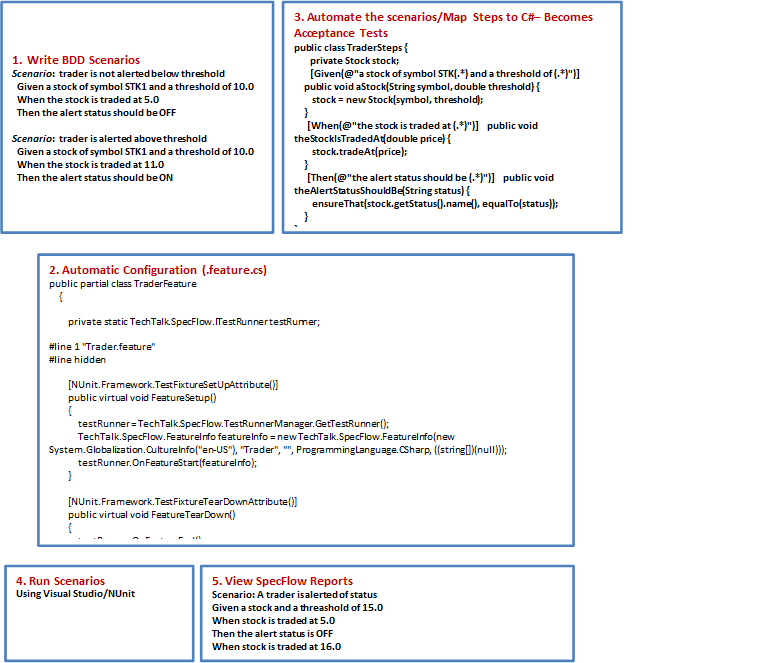
SpecFlow Workflow
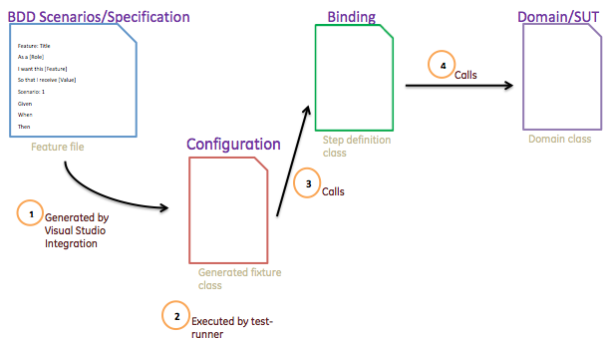
JBehave – BDD Tool for Java
JBehave is a BDD automated test tool for Java based application. It uses plain text Gherkin syntax. It maps the scenarios in Gherkin to steps in Java using annotations.
JBehave Example
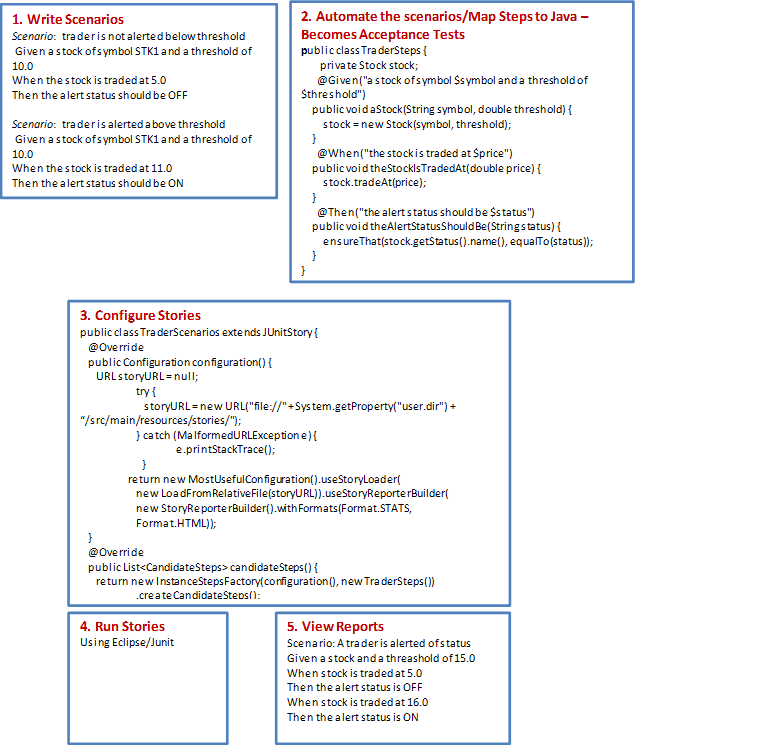
JBehave Workflow
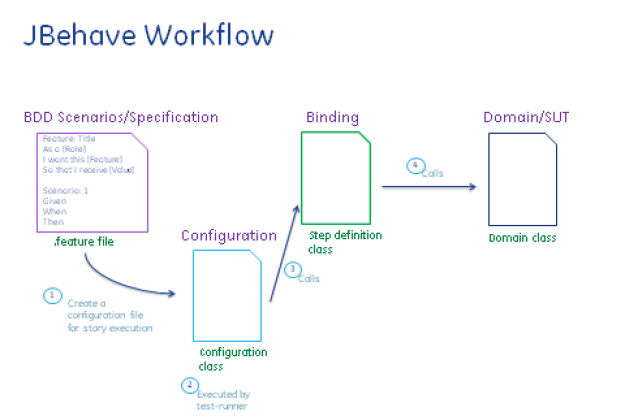





【推荐】国内首个AI IDE,深度理解中文开发场景,立即下载体验Trae
【推荐】编程新体验,更懂你的AI,立即体验豆包MarsCode编程助手
【推荐】抖音旗下AI助手豆包,你的智能百科全书,全免费不限次数
【推荐】轻量又高性能的 SSH 工具 IShell:AI 加持,快人一步
· 开发者必知的日志记录最佳实践
· SQL Server 2025 AI相关能力初探
· Linux系列:如何用 C#调用 C方法造成内存泄露
· AI与.NET技术实操系列(二):开始使用ML.NET
· 记一次.NET内存居高不下排查解决与启示
· 阿里最新开源QwQ-32B,效果媲美deepseek-r1满血版,部署成本又又又降低了!
· 开源Multi-agent AI智能体框架aevatar.ai,欢迎大家贡献代码
· Manus重磅发布:全球首款通用AI代理技术深度解析与实战指南
· 被坑几百块钱后,我竟然真的恢复了删除的微信聊天记录!
· AI技术革命,工作效率10个最佳AI工具